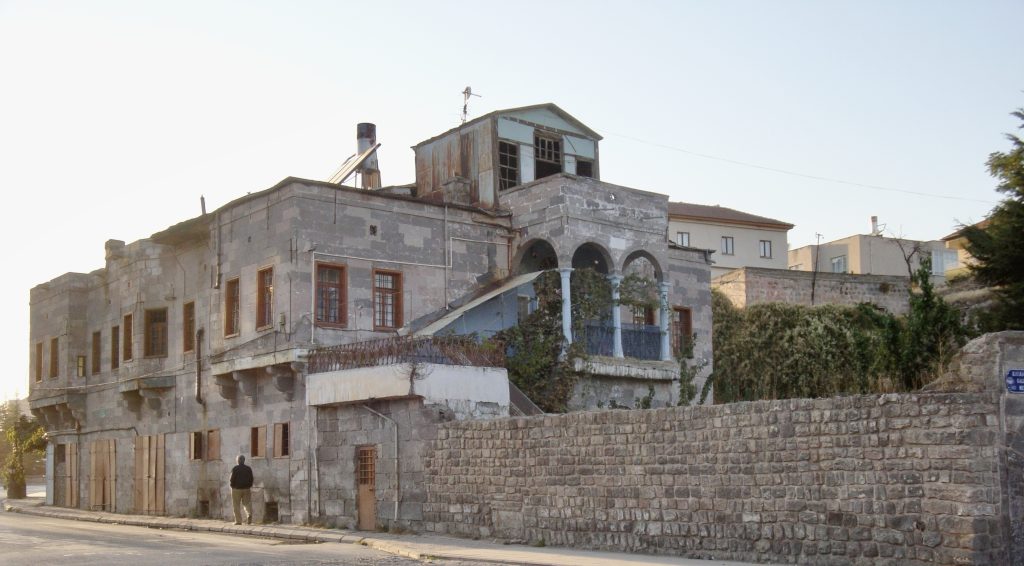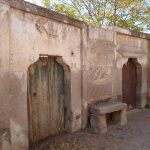I’m in Kayseri looking for a new yorgan (quilt) of the fast-vanishing old traditional type when I see a bus heading for Talas and decide to grab it instead. In 19th-century accounts of Kayseri it is usually Talas over which the writers wax most lyrical and if the jam-packed conditions on the bus are anything to go by it looks as if Talas is still where it’s at for a large part of the local population. But of course the Talas they’re heading for and the Talas I’m interested in are not at all the same thing. They pile out of the bus in front of a serried line of featureless high-rise apartment blocks. I stay on the now much more comfortable bus until eventually, off to the right, I spot what looks like the back of a quarry supporting the soaring dome of what was once the old Greek Orthodox church and is now the Yaman Dede Cami.
On a previous visit I remember being infuriated by banners strung across the main street touting “Yeşil Talas (Green Talas)” when there was about as much greenery amid the high-rises as there is is the Çarşamba district of İstanbul. It reminded me of China where the prettiest names always appeared to have been given to the grimmest of locations as if that might somehow prevent visitors from seeing the reality. Reminds me, too, of the way in which the least boutique of hotels are always the ones to append “butik” to their names. But the fact is that those old 19th-century writers also hymned a green Talas and within minutes of getting out of the bus I begin to see why.
It’s autumn now in Central Anatolia, the most beautiful of seasons as the foliage on the trees starts to take on blush hues. And, sure enough, here in old Talas, birthplace of Aristotle Onassis’s father, there are trees everywhere, their leaves shimmering yellow in the sunlight just as the Virginia creeper is morphing into red. Everywhere I look there are vines tumbling over trellises, berry-bearing bushes bearing down on the walls. The houses here were once built on terraces much as they were in Şirince near Ephesus. Now most have been torn down, leaving just arches and foundations backed up against the hillside. But as I wander around I come across one especially lovely house that has been renovated from top to toe, so clearly not all Kayseri’s burgeoning middle classes want to live in anonymous apartments.
Ten years ago I’d stood with my nose pressed up against the locked doors of the church, a few breaks in the woodwork permitting a glimpse of its shattered interior. Now it’s a newly restored gem and I’m quietly pleased to see that the brown signs directing visitors to it note in brackets that it was the Panaya Rum Kilisesi, the Greek church of St Mary. Today the stonework is sparkling, and if the Arabic for Allah does sit above a doorway which is un-Islamically decorated with swags of stone roses that only reflects a familiar pattern in which places retain religious significance despite changes in the prevailing culture. Inside I’m sad to see that the old altar has been completely eradicated, with a new mihrab punched into the old south wall of the church. But in the paintwork the ghostly outlines of saintly haloes commemorate the old frescoes and the elegant wooden galleries have been left in place. There are two worshippers in occupation, a man quietly reading the Koran and a woman in the curtained-off area in what would once have been the north aisle praying, then scrolling through her text messages. The caretaker bellows the usual questions about my origins until I’m forced to ask him to pipe down.
Beneath the church in the arched recesses that once housed jewellery shops there is now a small Kemeraltı Cafe. The owners have not been able to link up the rooms which leaves them looking a little cell-like. Still, ten years ago there would have been nothing like this here so I pause for a coffee just to appreciate the fact that I can.
Beyond the church a cobbled path strewn with straw heads towards the Han Cami, paid for by Sultan Abdülhamid II and with a dome that is a dead ringer for the one covering the tomb in Kayseri’s Cumhuriyet Meydanı. Across the road from it the hamam has been restored although I see no way to get into it. Further on I come across a restaurant and bar created around the remains of the old han, and then a square which now boasts a hospital and pharmacy alongside another 19th-century mosque. I’ve read that Talas is to get a real boutique hotel inside a house that was once home to Calouste Gulbenkian. This, I think, must be the Decoish-looking building high up on the ridge above the town and not obviously accessible.
Then just as I’m assuming I’ve “done” Talas and should be getting back to Kayseri I spot, across the main road, what looks like a rather fine 19th-century fountain. Unbelievably two plastic soap bowls have been attached to the sides of this graceful monument but while I’m taking this in I notice one of those large signboards that gives details of construction work and realise that I was about to leave without seeing Ali Saip Paşa Caddesi, the fine street of houses that was until recently subject to the sort of block restoration grant that used to be available in the UK (unbelievable as that too now seems). At the start of the street yet another mosque boasts a gate adorned with a glorious, colourful coat of arms. I’ve stopped to admire it when a man on a bike pauses. “The work’s stopped,” he says. “They ran out of money.”
We fall to chatting and he tells me that he lives in the house at the end of the street. “Is the restoration work good?” I ask.
“It was until the money ran out,” he says. “Stone is always better than concrete. With concrete it’s too hot in summer and too cold in winter.” Then he pedals off into the evening.
Further down the road I come across two women sitting on cushions across from a magnificent house. “Never finished,” they comment gloomily.
“But it’s beautiful, isn’t it?” I say. They just shrug their shoulders as if it’s never occurred to them to think about it.
At the end of the street stands a house with a wooden room tacked on at the top. In front of it are sitting an older woman and her daughter. “My mother has lived here all her life, ” the daughter says. “She was born here, she was married here and she’s still sitting here now.”
“And the house?”
“Well, it looks good from the outside. But it’s not convenient. There’s no sewerage, for example.” She, of course, has moved into a Kayseri apartment.
I wander back to the main road, wondering. I’m all in favour of restoration that improves exteriors so that everyone benefits from their beauty. On the other hand it must be very frustrating for people to see all that money being lavished on the outsides if on the inside their life is just as uncomfortable as before. It’s a situation not dissimilar to the one in Göreme, and there the consequence has been that the locals have moved out, leaving their old cave homes to be turned into hotels one and all.
Written: 7 October 2011


